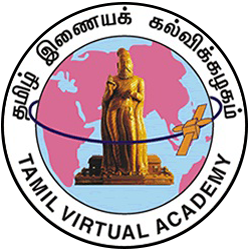Primary tabs
D03132 Cheyyul Vagai - Types of Verses
This lesson offers a brief introduction to ‘Pothuvaniiyal’, the first section of the grammar text ‘Dandialangaaram’. It then discusses the types of verses and the grammatical rules governing versification.
‘Dandialangaaram’ is the most important work on figures of speech (anigal). It comprises 3 sections: viz. ‘Pothuvaniiyal’, ‘Porulaniiyal’ and ‘Solaniiyal’. Of these, ‘Pothuvaniiyal’ which is the first section outlines the grammar that is common to ‘Porulaniiyal’ and ‘Solaniiyal’. Since ‘Dandialangaram’ analyses figures of speech through verses that employ them, an awareness of the rules governing versification is central to the understanding of figures of speech. ‘Pothuvaniiyal’ which is made of 25 verses i.e., (noorpa) is an extensive study of the types of verses and the grammar underlying them. It also offers an insight into the grammar of epic poetry and ‘andaadi’, a form of poetry. An understanding of ‘Pothuvaniiyal’ is essential for the appreciation of literary texts.
According to ‘Pothuvaniiyal’ there are 4 types of verses: viz. Muthagam, Kulagam, Thogainilai and Thodarnilai. The lesson offers a definition of these 4 types of verses and explains the grammar underlying their composition with suitable examples from literature.
A single verse that is independent and complete in itself in terms of meaning is called Muthagam. The individual verses in anthologies such as ‘Ettuthogai’ and ‘Pathupaatu’ belong to this type. A series of verses that are linked to one another either through their verb i.e., (vinai) or noun i.e., (peyar) endings are called Kulagam. Epics such as ‘Seevagasinthamami’, ‘Kambaramayanam’, ‘Periyapuraanam’ and ‘Nalavenba’ contain examples of this type of verse. A compendium of verses sung by one poet or many poets or an anthology of poems compiled on the basis of subject, time, place, action, verse type or verse length is called ‘Thogainilai Cheyyul’. For example, ‘Thirukkural’ is categorized as Thogainilai Cheyyul as it is a compilation of several verses written by one poet- Thiruvalluvar. ‘Kalithogai’ is a compendium of verses that have a common prosody or metric structure- the ‘Kalippa’. ‘Thodarnilai Cheyyul’ denotes a series of verses that are linked to each other through subject i.e., (porul) or word i.e., (sol). Epics are usually cited as examples of ‘Porul Thodarnilai Cheyyul’, while ‘Andaadis’ are a good example of ‘Sol Thodarnilai Cheyyul’. In Andaadis, the last word i.e., (sol), phrase or line of the preceding verse forms the opening of the one succeeding it.


